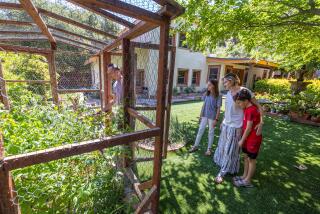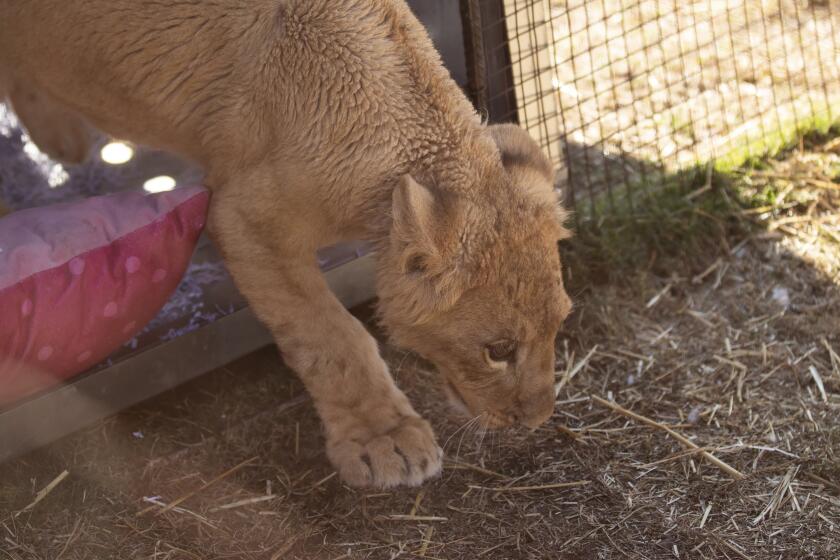First Captive California Condors Freed in Wild : Wildlife: Reintroduction of rare species comes 10 years after a disputed breeding program was started.
Two endangered California condors made biological history Tuesday as the first of their kind allowed to roam the wild since 1987, but for their first several hours of freedom, the birds refused to take flight.
Tuesday’s release--viewed as a major test of the nation’s endangered-species program--had been eagerly anticipated by biologists in the 10 years since a controversial captive-breeding program to save the vulture from extinction was launched.
“I’ve waited for this minute for five years,” said Jan Hamber, a UC Santa Barbara biologist who was involved in capturing the last condor in April, 1987. “We’re the ones who were here when the last ones were brought in. It’s just incredibly exciting to see the birds come back into the wild.”
The newly freed birds, however, savored their first hours of freedom on foot, hopping through chaparral. Scientists speculated that gusty winds may have discouraged the 8-month-old birds from taking flight.
The two California condors, along with two Andean condors as companions, were moved last October to a man-made cave near the edge of a 150-foot sandstone cliff in the Sespe Condor Sanctuary, in rugged backcountry 75 miles northeast of Los Angeles. The Andean condors, which do not crossbreed with the California condors, are not endangered.
Until Tuesday, the cave had served as a kind of ornithological halfway house to allow the birds to become accustomed to the sights and smells of living in the wild--but without the risks.
The cave and adjacent enclosed yard had been covered with a net to prevent the birds from flying away or falling off the steep cliff. But as the condors slept Tuesday night, biologists quietly removed the net. As the sun rose, the birds awakened to a new day that would bring a new milestone in the efforts to redress environmental mistakes.
At precisely 10:31 a.m. the door to the cave was opened by Red Star, a Chumash Indian. Moments later, the vultures emerged.
At first, they seemed unsure of what to do. Within an hour, however, both were venturing on foot beyond the formerly fenced perimeter as a huge group of scientists and reporters from throughout the world looked on.
But the birds simply refused to fly into the brilliant blue sky. Instead they hopped uptrail, poked into the chaparral and bounced on a ground-level scrub oak. At one point, the condor named Xewe (pronounced ga-wee) made his way up a rocky area overlooking the cave below and then flew to another boulder about 90 feet away. The flight was over in a moment.
There was only one mishap throughout the day. One of the Andean condors was blown off the cliff by a wind gust as the vulture stretched its nine-foot wings and hopped. The bird ended up in an oak tree near the base of the cliff, apparently uninjured. U.S. Forest Service officials said they may have to rescue it if it cannot fly back to the roost.
Even with that, “it was a pretty good day after a decade of waiting,” said Mike Wallace, curator of birds at the Los Angeles Zoo and one of the architects of the captive breeding program.
Biologists hope Xewe and its companion California condor, Chocuyens (cho-koo-yenz), will be the first of as many as six of the vultures to be set free each year at this time.
Condor recovery team leader Lloyd Kiff called this first release a “symbolic step” toward the recovery of the species.
“This is only two birds and you don’t recover a species with two birds,” said Kiff, who is the director of the Western Foundation of Vertebrate Zoology at the Los Angeles Zoo.
Once numbering in the thousands, the condor population dwindled significantly beginning in the 1950s as development encroached on its habitat. Some of the birds were shot or died of lead poisoning when they fed upon the carcasses of other animals killed with lead shot and bullets. Others died when they flew into high-tension power lines.
Five years ago, the last of the rare birds were taken from the wild and placed in captive breeding programs at the Los Angeles Zoo and at the San Diego Wild Animal Park. With the removal of the last bird, no condors were flying in North America’s skies for the first time since the Pleistocene Era nearly 2 million years ago.
“It’s a poetic thing that (Xewe) is the daughter of AC9, the last condor to be captured from the wild in 1987,” said Susie Kasielke, who supervised the breeding program at the Los Angeles Zoo.
From all appearances, the $15-million captive breeding program has been successful.
In 10 years, biologists at the two zoos have increased the California condor population to 52. There were only 27 when the last bird was captured.
To some, the release meant the condor recovery program had come full circle.
“This is the closing of the circle, one that from an emotional standpoint has been open way too long,” said ornithologist William D. Toone, a member of the condor recovery team from the San Diego Wild Animal Park. “From a biological standpoint it’s the tightest circle you could have spun.”
Toone said even the most optimistic scientists had not expected the birds would be freed until 1995. But the success of the captive breeding program allowed the date to be moved up to this week, he said.
Despite the reluctance of the condors to take flight, it was an occasion of celebration for all, especially Red Star, who had opposed taking the birds captive. He said an ancient Chumash prophecy warned that if the condor died, so too, would the tribe. He had feared that the birds would not fare well in captivity.
Two days earlier six members of various American Indian nations had come to the area to bless the release. Some of the Indians returned Tuesday, chanting and softly hitting a leather drum to coax the condors out of the cave and into flight.
“We just hope that our brothers do survive,” Red Star said of the birds.
Kiff pointed out that the birds will have help for an indefinite time. Scientists plan to continue providing stillborn baby calves to feed the condors in order to keep them healthy and entice them into returning to the sanctuary for their own safety.
For now, he said, “wild condors being fed artificially is better than condors in zoos. And condors in zoos is better than no condors at all.”
Times staff writer Joanna M. Miller contributed to this story.
More to Read
Start your day right
Sign up for Essential California for news, features and recommendations from the L.A. Times and beyond in your inbox six days a week.
You may occasionally receive promotional content from the Los Angeles Times.






